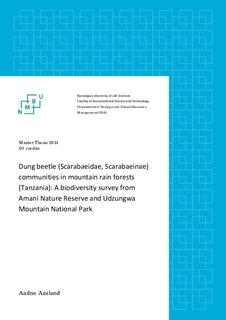| dc.description.abstract | The African dung beetles (Scarabaeidae, Scarabeinae) is the most generic and species rich of the global faunas. Dung beetles are good indicators of biodiversity and habitat disturbances. This study aimed to investigate dung beetle communities in two different mountain rain forests in the eastern arc mountains, Tanzania. The study areas were located in Amani Nature Reserve and Udzungwa Mountains National Park. In Amani, the tropical forest habitat has been reduced due to historical logging activities. In this area, five habitats were chosen: undisturbed forest, secondary forest that was logged approximately 50 years ago, agroforestry habitat, riverine secondary forest that was moderately logged in the past and a secondary forest that was moderately logged in the past. Due to unforeseen problems regarding the research permit, the field work in Udzungwa was conducted outside the protected forest, different habitats were thus not used since all plots were essentially within the same habitat type. In total, 1376 dung beetles, representing 59 different morphospecies were collected, using pitfall traps with three types of bait; cow dung, pig dung and meat. In Amani, 352 specimens grouped in 18 different morphospecies were sampled, in Udzungwa, 1024 specimens grouped in 41 different morphospecies were sampled, and no common species were found between the two study areas. The body size distribution of the dung beetle assemblage were smaller in Udzungwa compared to Amani. This result was unexpected because of the larger diversity and size range of mammals in Udzungwa compared to Amani. The habitats in Udzungwa were different, however, from the Amani forest habitats, and the
agricultural edges in Udzungwa may not represent the forest fauna. In Amani, the results from this study showed that the dung beetle composition were more evenly distributed in the undisturbed forest, this habitat also hosted the largest diversity of morphospecies. Results from Udzungwa showed significant differences in the dung beetle composition using different types of bait, where traps with pig dung constituted 74.7% of the total number of individuals in Udzungwa, with 16 morphospecies only occurring on this type of bait. In Amani, no significant differences in dung beetle composition were found between the type of bait used. Results from this study supported the use of dung beetles as bioindicator taxon for biodiversity and environmental changes and disturbances. Two assumed new species were found belonging to the genera Sceliages and Sarophorus. | nb_NO |
